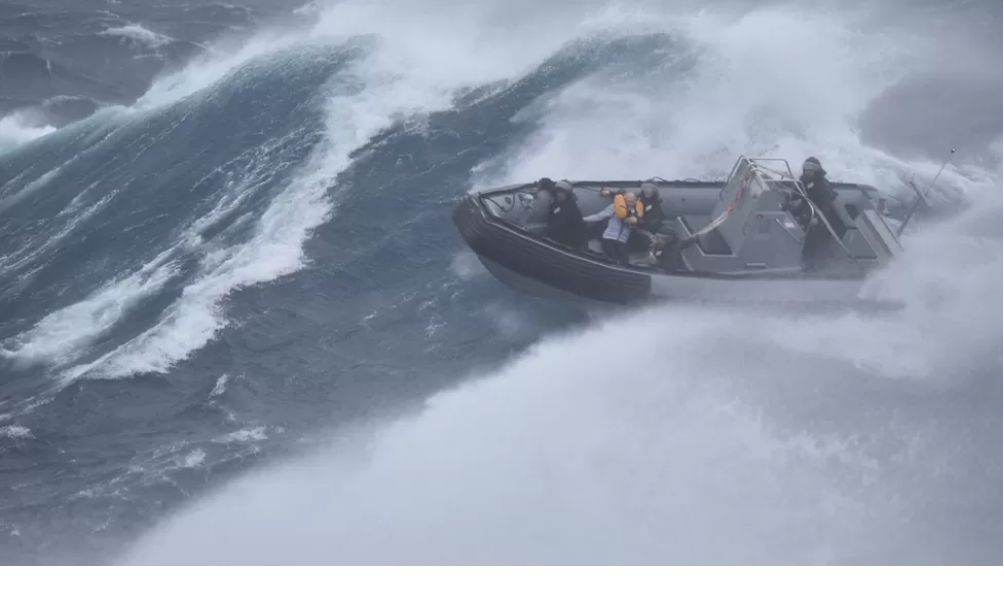NZ residents swim to safety amid Cyclone Gabrielle floods
Residents of New Zealand’s north have been forced to swim to safety from their flooded homes as a result of Cyclone Gabrielle.
Due to the storm’s devastation, the government declared a national state of emergency for only the third time in history on Tuesday.
ALSO READ: The US Recovers Suspected Chinese Spy Balloon’s Key Sensors
According to Prime Minister Chris Hipkins, this is New Zealand’s worst weather event in a century.
On Tuesday, officials reported that at least 225,000 people were without power.
A firefighter who was caught in a landslide in Muriwai, west of Auckland, remains missing. A second firefighter was critically injured, according to rescue agencies.
Hawke’s Bay, Coromandel, and Northland are among the worst-affected coastal communities in the extreme north and east of the North Island.
Almost a third of New Zealand’s 5,1 million inhabitants reside in affected regions.
Marcelle Smith, whose family resides in a cliff-front home in Parua Bay on the east coast of the North Island, reported to the BBC that she and her two young children had fled to higher ground on Monday night.
ALSO READ: Putin Withdraws Wagner Group Troops Amid Coup Fears in Ukraine
Her husband remained behind to secure the family’s residence. On Tuesday, some constructed embankments had already been washed away, and they were still battling severe weather.
“We are doing everything we can to protect what we have devoted our lives to,” she told the BBC. “It’s man versus nature at this point.”
According to local media, some residents of Hawke’s Bay were forced to swim through bedroom windows to escape their flooded homes. The local populace has been warned that they may be without electricity for weeks.
Aerial photographs of flooded regions revealed stranded individuals on rooftops awaiting rescue.
The extensive damage includes uprooted trees, bent streetlights and utility poles, and row after row of flooded residences.
The New Zealand Defense Force released dramatic photographs depicting the rescue of a sailor whose yacht was swept out to sea when its anchor cable snapped due to strong winds. Authorities reported that it was located off Great Barrier Island following an overnight search mission.
ALSO READ: MSU Gunman on the Loose: CCTV Images Released
Overnight, more than 100 people fled to evacuation centers in Auckland, according to officials.
Mr. Hipkins stated on Tuesday that the current level of destruction and severity has not been observed in a generation.
As the cyclone continues to develop, we are still piecing together a picture of its effects, but we do know that they are significant and widespread.
He has pledged NZ$11.5 million (£6 million; US$7.3 million) in aid to those affected by the disaster.
The Minister for Emergency Management, Kieran McAnulty, declared a national state of emergency on Tuesday morning, describing the storm as “unprecedented.”
The emergency order streamlines the government’s response to the catastrophe. It has been implemented throughout the regions of Northland, Auckland, Tairawhiti, Tararua, Bay of Plenty, Waikato, and Hawke’s Bay.
Only twice before has New Zealand declared a national state of emergency: at the beginning of the Covid-19 pandemic and after the 2011 Christchurch earthquake.
ALSO READ: UFO Shot Down Over Lake Huron
The government attributes the disaster’s severity to climate change.
James Shaw, minister of climate change, stated, “Its severity is exacerbated by the fact that our global temperatures have already risen by 1.1 degrees.”
We cannot bury our heads in the sand while the beach is flooding; we must act immediately.
Cyclone Gabrielle struck New Zealand just two weeks after four people were killed by unprecedented rainfall and flooding in the same region.
MetService, the country’s meteorological agency, reported on Tuesday that Auckland received approximately half of its annual precipitation in the first 45 days of 2023.
The MetService reports that conditions are expected to improve over the next few days, and heavy rain warnings have been lifted for certain regions of the country. However, it has warned that wind may still cause additional damage.
READ MORE:
- Make April your winning month with AfroPari! Make April your winning month with AfroPari! March flew by, bringing many exciting matches and
- Why Money Collected From Tourists Was Banked in Swiss Accounts – Gov’tWhy Money Collected From Tourists Was Banked in Swiss Accounts – Gov’t The Kenyan government
- Hanna Cheptumo Says Her Family Is Worth Ksh.420 Million During Cabinet VettingHanna Cheptumo Says Her Family Is Worth Ksh.420 Million During Cabinet Vetting NAIROBI, Kenya –
- Ruto’s Gender CS Pick Blames Femicide on ‘Greedy Women Chasing Money’ — Claims Education and Independence Could Stop the KillingsRuto’s Gender CS Pick Blames Femicide on ‘Greedy Women Chasing Money’ — Claims Education and
- Kelvin Kiptum’s Father Demands Justice and Compensation from President RutoKelvin Kiptum’s Father Demands Justice and Compensation from President Ruto Over a year after the





